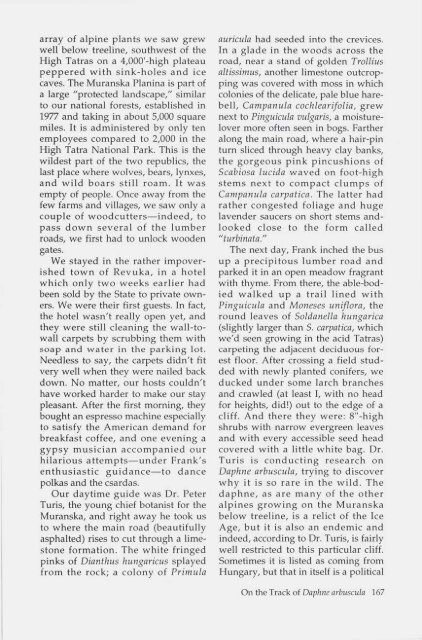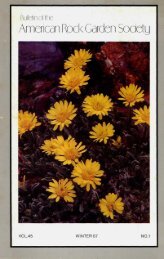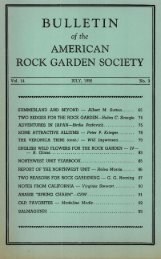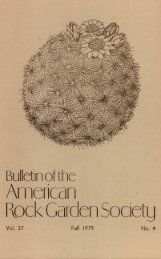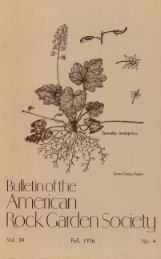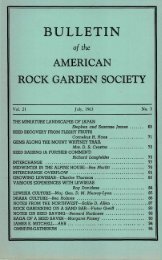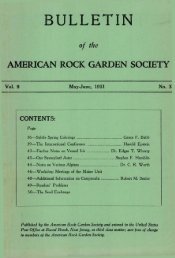After the gardenesque comfort ofthe western Carpathians, the brutallyglaciated granite peaks of Slovakia'sHigh Tatras came as a shock. We hadtraveled along the highly industrializedVah River to the city of Poprad,where chemical plants belched fumesover a high plain. And there in the distance,thrusting into the sky as abruptlyas the Grand Tetons, was a smallcluster of rugged peaks: at 8,500',much taller than we ever imagined,yet occupying not much more territorythan the island of Manhattan. TheHigh Tatras is a national park and alsoan enormously popular tourist and skiresort—both the Czech Republic andSlovakia are incredible vacation bargainsfor most Europeans.We frittered away most of a morningon still another Dactylorhiza besidethe road, but finally, about noon, a fewof us started up a trail with severalthousand tourists and the parkbotanist, Dr. Rudolf Soltes, a burlyman who is an eminent expert onlichens. We hadn't even entered thewoods before we saw one of the outstandingplants of our trip: Campanulatatrae, a bellflower in the rotundifoliacomplex (photo, p. 223). This onemakes a neat clump and has sumptuouspurple bells hanging in profusionon sturdy, 6" stems; apparently, it isnot in general cultivation—but shouldbe. The trail rose through the forest—we nearly stumbled over a Soldanellacarpatica nestled among the rocks—and wound into a stand of mughopines, where the purple-spotted yellowflowers of 18"-tall Gentiana punctatawere magnificent. Eventually, thepath emerged on a gentle alpinemeadow of turf and willows. Beyond,the path to a hanging valley and lakewas blocked by a cliff that had beendraped with what looked like a cargonet. Anyone wishing to climb up hadto pay a fee to a park functionary.By then, only Borek was with us."Joan, I don't think you should go farther,"he said. I didn't think so either,so we contented ourselves with theplants at hand. Campanula alpinacaught our attention immediately(photo, p. 222). Huddled against bouldersout of the wind, it had furry littleleaves and 4" stems carrying severallarge, purple bells, The last few goldbossed,white cups of Pulsatilla alpinanodded in the wind; glistening whitedaisies of Chrysanthemum (Leucanthemopsis)alpinum hugged the ground;and along the brook tumbling from thehanging lake, mats of the rather succulentleaves of Arabis alpina were toppedby long-stemmed white flowers.Paul was afraid of ski lifts, so six ofus interested in alpine plants left thegroup the next day to ride a chair tojust below the snow line. There wasanother fee for those wishing to hikethe trail to a lake, but we were happyenough crawling over a steep slope ofturf and scree, as Borek and Frankwatched over us like sheep dogs fromthe lift terminus. With the added altitude,we found pulsatillas newlyopened, along with the glisteningwhite, multi-flowered inflorescences ofAnemone narcissiflora (photo, p. 222). Apatch of Silene acaulis mingled with ahandsome plant new to me, Pedicularisverticillata, with typical ferny foliageand, on stems only a few inches high,heavy little spikes of brilliant pinkflowers (photo, p. 223). A very different,classic alpine was far less conspicuous.We'd been kneeling on it, and itsmossy matrix, for an hour before werealized that the dime-sized rosettes ofshiny, little, notched leaves were thoseof Primula minima. The big pink flowershad been replaced by capsules, butthe slope must have been spectacularwith them a month earlier.Still, for biodiversity, nothing beatslimestone. As it turned out, the largest166 <strong>Bulletin</strong> of the <strong>American</strong> <strong>Rock</strong> <strong>Garden</strong> <strong>Society</strong> Vol. 52:3
array of alpine plants we saw grewwell below treeline, southwest of theHigh Tatras on a 4,000'-high plateaupeppered with sink-holes and icecaves. The Muranska Planina is part ofa large "protected landscape/' similarto our national forests, established in1977 and taking in about 5,000 squaremiles. It is administered by only tenemployees compared to 2,000 in theHigh Tatra National Park. This is thewildest part of the two republics, thelast place where wolves, bears, lynxes,and wild boars still roam. It wasempty of people. Once away from thefew farms and villages, we saw only acouple of woodcutters—indeed, topass down several of the lumberroads, we first had to unlock woodengates.We stayed in the rather impoverishedtown of Revuka, in a hotelwhich only two weeks earlier hadbeen sold by the State to private owners.We were their first guests. In fact,the hotel wasn't really open yet, andthey were still cleaning the wall-towallcarpets by scrubbing them withsoap and water in the parking lot.Needless to say, the carpets didn't fitvery well when they were nailed backdown. No matter, our hosts couldn'thave worked harder to make our staypleasant. After the first morning, theybought an espresso machine especiallyto satisfy the <strong>American</strong> demand forbreakfast coffee, and one evening agypsy musician accompanied ourhilarious attempts—under Frank'senthusiastic guidance—to dancepolkas and the csardas.Our daytime guide was Dr. PeterTuris, the young chief botanist for theMuranska, and right away he took usto where the main road (beautifullyasphalted) rises to cut through a limestoneformation. The white fringedpinks of Dianthus hungaricus splayedfrom the rock; a colony of Primulaauricula had seeded into the crevices.In a glade in the woods across theroad, near a stand of golden Trolliusaltissimus, another limestone outcroppingwas covered with moss in whichcolonies of the delicate, pale blue harebell,Campanula cochlearifolia, grewnext to Pinguicula vulgaris, a moisturelovermore often seen in bogs. Fartheralong the main road, where a hair-pinturn sliced through heavy clay banks,the gorgeous pink pincushions ofScabiosa lucida waved on foot-highstems next to compact clumps ofCampanula carpatica. The latter hadrather congested foliage and hugelavender saucers on short stems andlookedclose to the form called"turbinata."The next day, Frank inched the busup a precipitous lumber road andparked it in an open meadow fragrantwith thyme. From there, the able-bodiedwalked up a trail lined withPinguicula and Moneses uniflora, theround leaves of Soldanella hungarica(slightly larger than S. carpatica, whichwe'd seen growing in the acid Tatras)carpeting the adjacent deciduous forestfloor. After crossing a field studdedwith newly planted conifers, weducked under some larch branchesand crawled (at least I, with no headfor heights, did!) out to the edge of acliff. And there they were: 8"-highshrubs with narrow evergreen leavesand with every accessible seed headcovered with a little white bag. Dr.Turis is conducting research onDaphne arbuscula, trying to discoverwhy it is so rare in the wild. Thedaphne, as are many of the otheralpines growing on the Muranskabelow treeline, is a relict of the IceAge, but it is also an endemic andindeed, according to Dr. Turis, is fairlywell restricted to this particular cliff.Sometimes it is listed as coming fromHungary, but that in itself is a politicalOn the Track of Daphne arbuscula 167
- Page 5 and 6: On the Track ofDaphne arbusculaby J
- Page 7: ecause, having failed to get us to
- Page 11 and 12: CalochortusSensational Native Ameri
- Page 13 and 14: improving subdrainage, increasing o
- Page 15 and 16: ulbs were placed, covered with thes
- Page 17 and 18: Harmony with Natureby Jaroslav Faif
- Page 19 and 20: Blechnum penna-marina (p. 183) phot
- Page 21 and 22: Athyrium niponicum var. pictum (pp.
- Page 23 and 24: Pacific Treasuresfor the Temperate
- Page 25 and 26: vated with every precaution availab
- Page 27 and 28: South African JournalKarroo to the
- Page 29 and 30: plant completely covers its muchbra
- Page 31 and 32: from a distance the mesas and landf
- Page 33 and 34: maroon capsules. Some of the barren
- Page 35 and 36: north of the main Drakensbergescarp
- Page 37 and 38: startled to find large mounds ofNer
- Page 39 and 40: Aptosimum procumbens at Sutherland
- Page 41 and 42: Hermannia cf. stricta, on Hamtamber
- Page 43 and 44: Blue Mountain Pass, South Africa (p
- Page 45 and 46: Agapanthus campanulatus ssp. patens
- Page 47 and 48: TroughsA Few More Commentsby Waid V
- Page 49 and 50: Androsace—would be ideal except m
- Page 51 and 52: AlpsWaid Vanderpoel, Barrington, Il
- Page 53 and 54: method, while very labor intensive,
- Page 55 and 56: What Do They Want?by Bob Noldfew ye
- Page 57 and 58: SeedExchange1994Seed listings will
- Page 59 and 60:
AwardsAward of MeritGiven to person
- Page 61 and 62:
given many programs: slides, worksh
- Page 63 and 64:
Faiferlik garden
- Page 66 and 67:
224 Bulletin of the American Rock G
- Page 68 and 69:
Edgar T. Wherry AwardGiven to a per
- Page 70 and 71:
hoping to get some pictures. The wi
- Page 72 and 73:
ORDER NOW!!at the special pre-publi
- Page 74 and 75:
J^SKIYOLT* RARE PIXANTJVURSERY"An e
- Page 76 and 77:
uCOf^mFor over 20 yearswe have spec
- Page 78 and 79:
WE-DU NURSERIESA SPECIALTY NURSERY
- Page 80 and 81:
Books—mostly at 80% list priceN-A
- Page 82 and 83:
Chapter ChairpersonsAdirondackAlleg


